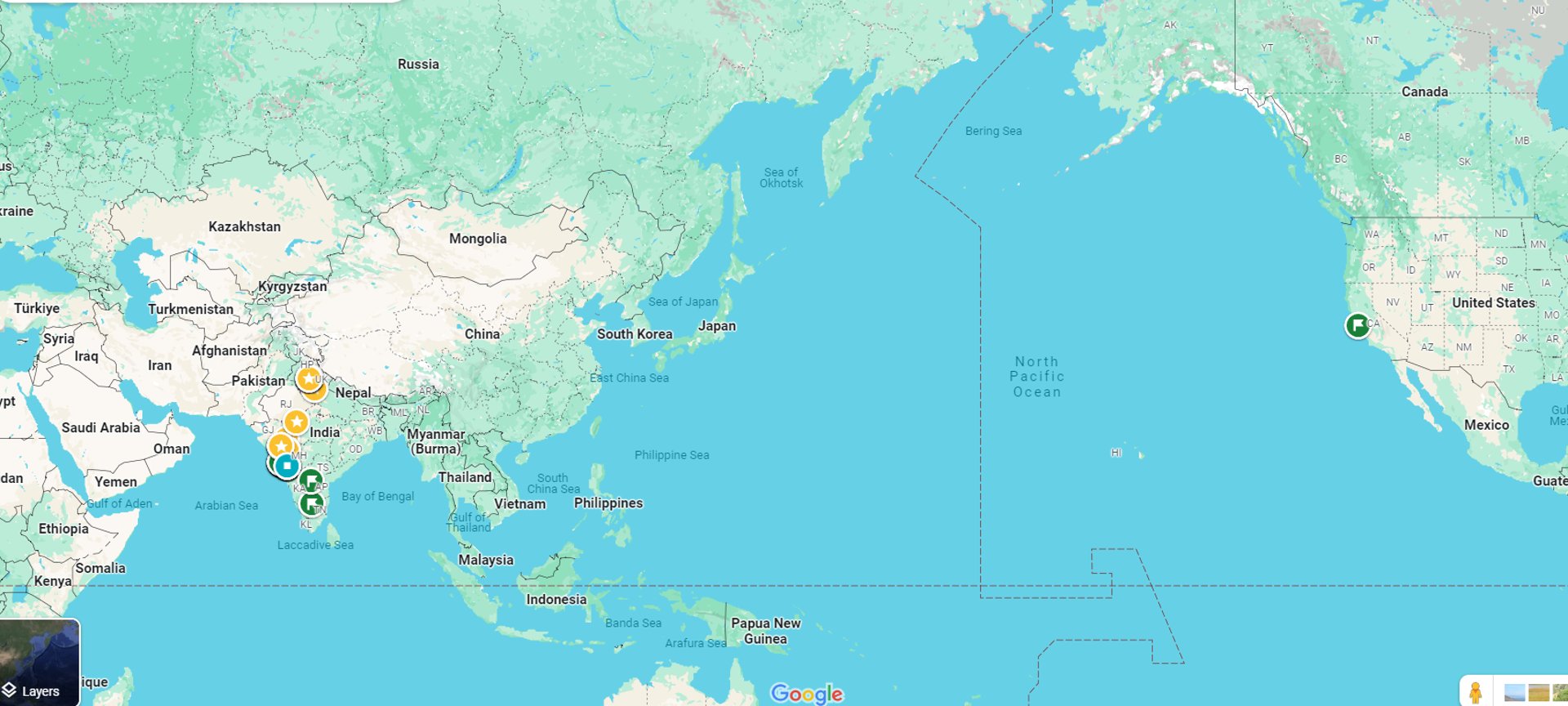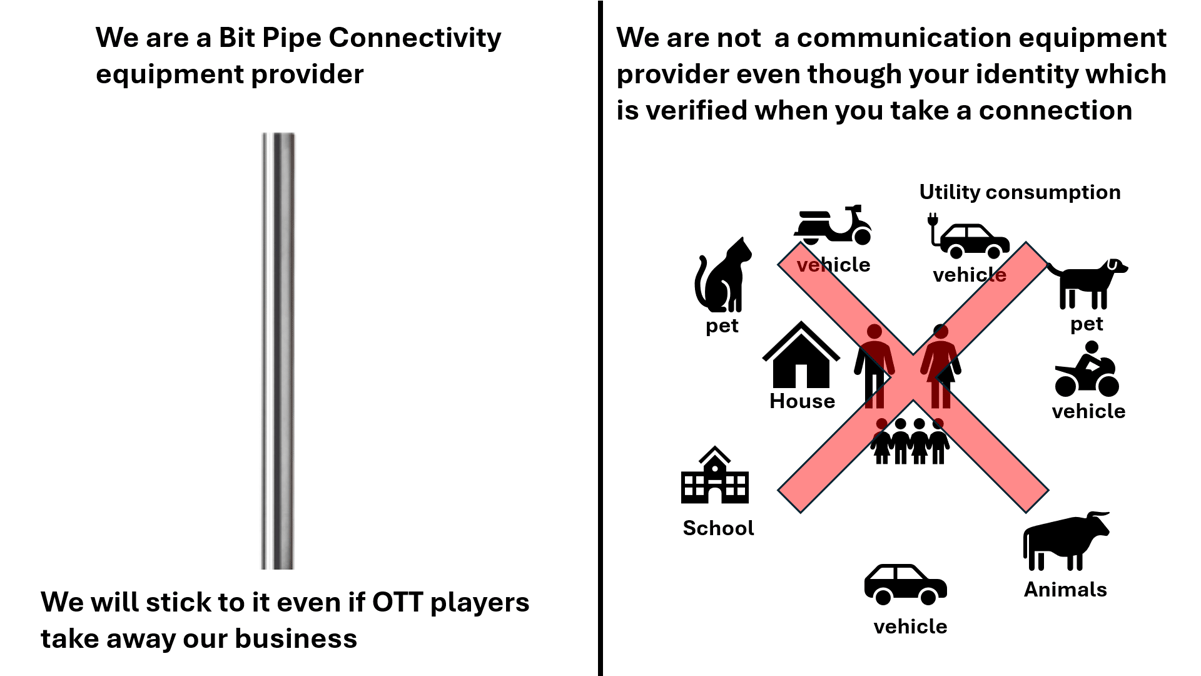
The Telecom Operators VBE Model Part 3
Part 3 explains why the Telecom operators need to change the Model from a data pipe operator equipment supplier model to an Identity and Data enabler supplier model. And a key enabler for this would be the incumbent companies who could protect their business from the challengers. The third part focusses on the equipment users being locked in being a data pipe operator connectivity provider while their advantages with each G transition reduces from 1G to 5G and further it will be difficult to sell 6G and 7G without offering advantages to the users, this necessitates shifting the VBE model from being a data pipe operator connectivity provider to an identity and use services connectivity provider. Also the new technology companies like LEO players remove the need of the intermediatory operator and the LEO companies can connect directly to the users, eliminating the need for the player like a telecom operator. Which means the entire telecom operators customer base of Ericsson, Nokia and Huawei may be redundant.
Abhijeet Kelkar
4/1/20256 min read
Write your text here...


My post content
Not thinking through the VBE model will make these companies bankrupt. History repeats itself
In this part we look at the issues the Telecom operators have with their Infrastructure Investments and the main advantages areas the telecom operators are sitting on, and we then see how the telecom equipment players could build a VBE model around the advantages the telecom operators VBE model.
We first look at the complaints the telecom operators make on OTT players. OTT stands for Over the Top Players who benefit from the connectivity services the telecom operator provides to their customers. Their grudge is that the Telecom operators invest in the Infrastructure to provide connectivity for consumers so that they can access data in the covered network areas, the Network operators have paid licencing fees to the government which gives them licences to operate their services in a given area so that they can use the bandwidth spectrum. Bandwidth spectrum refers to the range of frequencies allocated to wireless communication.
In Telecommunications the bandwidth spectrum is used by Mobile Networks (2G, 3G, 4G, 5G, 6G) where Operators use licensed spectrum bands to transmit voice, video, and data. And tis also used for Wi-Fi, Bluetooth, and Satellite Communication: Different frequency bands are used for various wireless applications.
Licensed is the spectrum an operator buys exclusive rights through government auctions while Unlicensed Spectrum is the spectrum open for public use for example Wi-Fi operates at 2.4GHz and 5GHz.
Frequency Bands & Usage
Spectrum Band Frequency Range Usage
Low Band Below 1 GHz Long-range, rural coverage (e.g., 700 MHz for 4G, 600 MHz for 5G)
Mid Band 1GHz – 6 GHz Balance of speed and coverage (e.g., 2.5 GHz, 3.5 GHz for 5G)
High Band (mm Wave) Above 24 GHz Extremely fast speeds, short range (e.g., 26 GHz, 28 GHz for 5G)
Importance in 5G & 6G
5G relies on mid-band and mm Wave for high speeds.
6G (expected by 2030) may use terahertz (THz) frequencies for ultra-fast connectivity.
In short, bandwidth spectrum is the lifeline of wireless communication, determining speed, coverage, and efficiency of networks worldwide.
The issues the telecom operators have around the Investments they make is they give access to users for data usage, but the revenue flows to the Over the Top Players and they have a revenue loss to the OTT (Over-the-Top) players, which provide services like messaging, voice calls, and video streaming over the internet, bypassing traditional telecom networks. Here are the key issues:
1. Revenue Loss
Decline in Voice & SMS Revenue: Services like WhatsApp, Zoom, and Skype have replaced traditional calls and SMS, reducing revenue for telecom operators.
Flat Data Pricing: While OTT players generate high data usage, telecom operators often struggle to monetize it effectively due to competitive data pricing.
2. Network Strain & Investment Burden
Increased Data Traffic: OTT platforms (Netflix, YouTube, TikTok) consume vast amounts of bandwidth, requiring telcos to invest in network expansion and 5G rollouts.
No Revenue Share: Despite heavy network usage, OTT players do not contribute to infrastructure costs, leaving telcos to bear the investment burden alone.
3. Regulatory Imbalance
Unequal Regulations: OTT players operate with fewer regulatory constraints compared to telecom operators, who must comply with strict licensing, taxation, and security regulations.
Lack of Fair Competition: OTT services can launch globally without investing in local infrastructure, unlike telecom operators who must build networks and obtain licenses.
4. Customer Relationship & Brand Erosion
Loss of Direct Customer Engagement: Telecom companies are reduced to being "dumb pipes," while OTT players own the customer experience and data.
Churn & Loyalty Issues: Customers increasingly choose OTT services for communication, making it harder for telecom operators to differentiate themselves.
5. Monetization Challenges
Bundling & Partnerships: Telcos are forced to bundle OTT services (e.g., Netflix, Spotify) with their plans to remain competitive, but the revenue share is often low.
Pressure to Develop New Revenue Streams: Operators must explore new business models, such as cloud services, IoT, enterprise solutions, and content partnerships, to stay relevant.
Possible Responses by Telecom Operators
Network-Based Charging Models: Some telcos push for a “fair share” model where OTT players contribute to network costs.
Bundling & Partnerships: Collaborating with OTT players (e.g., free YouTube or Netflix subscriptions with data plans) to retain users.
Expansion into Digital Services: Developing their own OTT platforms (e.g., JioTV, Airtel Xstream) and venturing into cloud, security, and AI-driven services.
The battle between telecom operators and OTT players continues as telcos seek ways to remain competitive while ensuring sustainable revenue growth.
But they are locked into being a data Pipe operator for their revenues. The only way a telecom operator differentiates its services is the amount of data it gives for the money it charges. Thus, the Telecom operators compete against one another to provide more value than its competitors resulting in a revenue erosion that we saw in the drop of revenues for Telia Sonera in Part 1 above.
But now lets us look at the regulatory advantages the telecom operator sits on and why this is important for the Telecom equipment maker to enable the new VBE model.
The three Oil fields or gold mines the telecom operator sits on is.
1. Verified identity of a user
2. Access to a user
3. Location of a user
And I would like to differentiate that none of the other verticals like retailers or Banks and Insurance companies or Institutions have access to these three advantages which the telecom operators have. The first is verified identity of a user globally ensures that a telecom operator knows that the person they provide data services to is a real person who is verified in many countries with a biometric identity, the second is that they have access to a user 24X7. And thirdly they know their location 24X7. These three advantages can give the VBE model they participate an inherent advantage when competing with the OTT players. The OTT players are not sure of the identity of the users and make money on these identities by running the advertising model. While the Telecom operators sit on the identity access and location which in my view are gold nuggets and complain about the OTT players taking revenue around identity.
The basis for the telecom operators is to use a VBE model so that its users benefit from the identity enablement services the telecom operators can give their consumers. The thinking for Ericsson Nokia and Huawei must change from being a data pipe equipment provider to an Identity and Data Services enabler model. This will drive revenues for the telecom operators.
Now the reader will question as to why have the equipment providers been in business for the last 100 years, will have trouble with its business and the answer to this is quite simple, till today when the equipment providers went from upgrading from 1G to 2G and then to 3G and then 4G with each G transition there was a value the users had in the service upgradation, from 1G to 2 G you got sms and digital voice resulting in better call quality, with 2G to 3G you got Data and video , with 3G to 4G you got faster data speeds and ability to do video calls and access to services like Skype for international calling etc. The bottom line was with each G transition the advantages were clear for the user to use and with each G transition the value the user got became less and less and with the transition from 4G to 5G the user did not perceive a big value change. On top of it the Telecom operator has a pressure on its prices so when 5G came, there was no added revenue for a telecom operator and he still had to invest in 5G network and remove its 4G Infrastructure on the premise of telecom equipment manufacturers promise that it was new infrastructure that would neither bring added visible benefits to their customers and more revenues if they invested in 5G and removed their 4G infrastructure. So there was no immediate interest for the telecom operators to switch from 4G to 5G. However using the VBE model we have suggested, the telecom operators and their customers would benefit from the identity and use cases thereby increasing revenues for their customers if they switched to 5G and also giving their customers value cases to benefit from. The VBE model will address the sustainability and circularity angle for the ecosystem. Which creates a good push and story for all participants in the telecom ecosystem.
In part 4 I will cover what will happen if Ericsson and Nokia and Huawei continue along the data Pipe equipment provider model and do not transition to the identity and data services enabler model, a model they are already sitting on.
Insights
Transforming business analysis for future resilience.
Consulting
Strategy
info@geoown.com
© 2025. All rights reserved.
